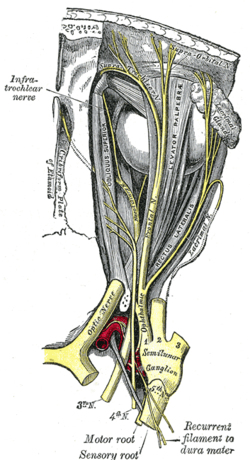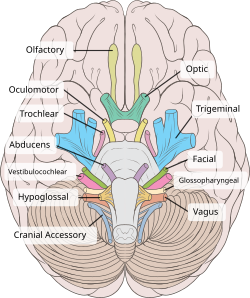
Back عصب محرك للعين Arabic Gözün hərəki siniri Azerbaijani Вокарухальны нерв Byelorussian Nervi motor ocular comú Catalan Okohybný nerv Czech Nervus oculomotorius Danish Nervus oculomotorius German Κοινό κινητικό νεύρο Greek Nervus oculomotorius Esperanto Nervio oculomotor Spanish
This article includes a list of general references, but it lacks sufficient corresponding inline citations. (April 2014) |
| Oculomotor nerve | |
|---|---|
 Nerves of the orbit. Seen from above. | |
 Inferior view of the human brain, with the cranial nerves labelled. | |
| Details | |
| From | Oculomotor nucleus, Edinger-Westphal nucleus |
| To | Superior branch, inferior branch |
| Innervates | Superior rectus, inferior rectus, medial rectus, inferior oblique, levator palpebrae superioris, sphincter pupillae (parasympathetics), ciliaris muscle (parasympathetics) |
| Identifiers | |
| Latin | nervus oculomotorius |
| MeSH | D009802 |
| NeuroNames | 488 |
| TA98 | A14.2.01.007 |
| TA2 | 6187 |
| FMA | 50864 |
| Anatomical terms of neuroanatomy | |
| Cranial nerves |
|---|
|
The oculomotor nerve, also known as the third cranial nerve, cranial nerve III, or simply CN III, is a cranial nerve that enters the orbit through the superior orbital fissure and innervates extraocular muscles that enable most movements of the eye and that raise the eyelid. The nerve also contains fibers that innervate the intrinsic eye muscles that enable pupillary constriction and accommodation (ability to focus on near objects as in reading). The oculomotor nerve is derived from the basal plate of the embryonic midbrain. Cranial nerves IV and VI also participate in control of eye movement.[1]
- ^ Vilensky, Joel; Robertson, Wendy; Suarez-Quian, Carlos (2015). The Clinical Anatomy of the Cranial Nerves: The Nerves of "On Olympus Towering Top". Ames, Iowa: Wiley-Blackwell. ISBN 978-1-118-49201-7.[page needed]
© MMXXIII Rich X Search. We shall prevail. All rights reserved. Rich X Search